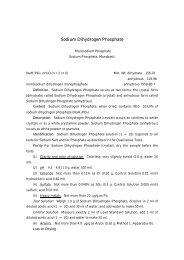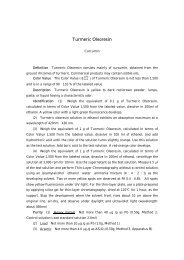Create successful ePaper yourself
Turn your PDF publications into a flip-book with our unique Google optimized e-Paper software.
<strong>Food</strong> <strong>Red</strong> <strong>No</strong>. <strong>40</strong><br />
Alurared AC<br />
C18H14N2Na2O8S2 Mol. Wt. 496.43<br />
disodium salt of 6-hydroxy-5-(2-methoxy-5-methyl-4-sulfophenylazo)-2-naphthalenesulfonic<br />
acid<br />
25956-17-6<br />
Definition <strong>Food</strong> <strong>Red</strong> <strong>No</strong>. <strong>40</strong> is obtained by coupling diazotized<br />
4-amino-5-methoxy-2-methylbenzenesulfonic acid with 6-hydroxy-2-naphthalene-<br />
sulfonic acid, salting out, and refining. It consists principally of the disodium salt of<br />
6-hydroxy-5-(2-methoxy-5-methyl-4-sulfophenylazo) -2-naphthalenesulfonic acid<br />
(C18H14N2Na2O8S2).<br />
Content <strong>Food</strong> <strong>Red</strong> <strong>No</strong>. <strong>40</strong> contains the equivalent of not less than 85.0% of the<br />
disodium salt of 6-hydroxy-5-(2-methoxy-5-methyl-4-sulfophenylazo)-2-naphthalene<br />
sulfonic acid.<br />
Description <strong>Food</strong> <strong>Red</strong> <strong>No</strong>. <strong>40</strong> occurs as dark red powder or granules. It is<br />
odorless.<br />
Identification (1) <strong>Food</strong> <strong>Red</strong> <strong>No</strong>. <strong>40</strong> solution (1 1,000) is red in color.<br />
(2) A solution of <strong>Food</strong> <strong>Red</strong> <strong>No</strong>. <strong>40</strong> in sulfuric acid (1 100) is dark red-purple in<br />
color. Add 2 to 3 drops of this solution to 5 ml of water. A red color develops.<br />
(3) Dissolve 0.1 g of <strong>Food</strong> <strong>Red</strong> <strong>No</strong>. <strong>40</strong> in 100 ml of ammonium acetate solution (3<br />
2,000). To 1 ml of this solution, add ammonium acetate solution (3 2,000) to make<br />
100 ml. This solution exhibits absorption maximum at a wavelength of 497501 nm.<br />
Purity (1) Water-insoluble substances <strong>No</strong>t more than 0.20% (Coloring Matter<br />
Tests).<br />
(2) Chloride and sulfate <strong>No</strong>t more than 5.0% as total amount (Coloring Matter<br />
Tests).<br />
(3) Heavy metals <strong>No</strong>t more than 20 µg/g as Pb (Coloring Matter Tests, Heavy
Metals (5)).<br />
(4) Lead <strong>No</strong>t more than 10 µg/g as Pb.<br />
Test Solution Use 10 ml of the test solution prepared in (3).<br />
Control Solution To 1.0 ml of Lead Standard Solution, add diluted hydrochloric<br />
acid (14) to make 20 ml.<br />
(5) Arsenic <strong>No</strong>t more than 4.0 µg/g as As2O3 (Coloring Matter Tests).<br />
(6) Lower sulfonated subsidiary colors <strong>No</strong>t more than 1.0%.<br />
Test Solution Weigh accurately about 100 mg of <strong>Food</strong> <strong>Red</strong> <strong>No</strong>. <strong>40</strong>, dissolve in<br />
ammonium acetate solution (7.7 1,000) to make exactly 100 ml.<br />
Standard Solution Weigh 10.0 mg each of cresidine sulfonic acid azo <br />
-naphthol and cresidine azo Schaeffer's salt, dried previously in a vacuumed desiccator<br />
for 24 hours, dissolve each in ammonium acetate solution (7.7 1,000), and make<br />
exactly 100 ml. Use each solution as the standard stock solution. Proceed as directed<br />
under the Coloring Matter Tests (Subsidiary Colors).<br />
Procedure Determine the amount of cresidine sulfonic acid azo -naphthol and<br />
cresidine azo Schaeffer's salt in the test solution as directed under the Coloring Matter<br />
Tests (Subsidiary Colors), and calculate the total amount.<br />
Operating Conditions<br />
Determination wavelength: 515 nm.<br />
Mobile phase: A. Ammonium acetate solution (7.7 1,000), B. Methanol.<br />
Concentration gradient: Change linearly the ratio of A : B from 100 : 0 to 0 :<br />
100 for 50 minutes.<br />
(7) Higher sulfonated subsidiary colors <strong>No</strong>t more than 1.0%.<br />
Test Solution Use 20 µl of the test solution prepared under test (6).<br />
Standard Solution Weigh 10.0 mg each of cresidine sulfonic acid azo G salt and<br />
cresidine sulfonic acid azo R salt, dried previously in a vacuumed desiccator for 24<br />
hours, dissolve each in ammonium acetate solution (7.7 1,000), and make exactly<br />
100 ml. Use each solution as the standard stock solution. Proceed as directed under the<br />
Coloring Matter Tests (Subsidiary Colors).<br />
Procedure Perform Liquid Chromatography under the operating conditions<br />
specified in (6), as diredcted under the Coloring Matter Tests (Subsidiary Colors).<br />
Determine each amount of cresidine sulfonic acid azo G salt and cresidine sulfonic acid<br />
azo R salt in the test solution, and calculate the total amount.<br />
(8) Monosodium salt of 6-hydroxy-2-naphthalenesulfonic acid <strong>No</strong>t more than<br />
0.3%.<br />
Test Solution Use 20 µl of the test solution prepared under test (6).
Standard Solution Weigh 10.0 mg of monosodium salt of 6-hydroxy-2<br />
-naphthalenesulfonic acid, dried in a vacuumed desiccator for 24 hours, dissolve in<br />
ammonium acetate solution (7.7 1,000) to make exactly 100 ml. Use this solution as<br />
the standard stock solution. Proceed as directed under the Coloring Matter Tests<br />
(Unreacted raw materials and products of side reactions)<br />
Procedure Determine the amount of monosodium salt of 6-hydroxy-2<br />
-naphthalenesulfonic acid in the test solution, as directed under the Coloring Matter<br />
Tests (Unreacted raw materials and products of side reactions).<br />
Operating Conditions<br />
Determination wavelength: 290 nm.<br />
Mobile phase: A. Ammonium acetate solution (7.71,000), B. Methanol.<br />
Concentration gradient: Change linearly the ratio of A : B from 100 : 0 to 0 :<br />
100 for 50 minutes.<br />
(9) 4-Amino-5-methoxy-2-methylbenzenesulfonic acid <strong>No</strong>t more than 0.2%.<br />
Test Solution Use 20 µl of the test solution prepared in test (6).<br />
Standard Solution Weigh 10.0 mg of 4-amino-5-methoxy-2<br />
-methylbenzenesulfonic acid, dried in a vacuumed desiccator for 24 hours, dissolve in<br />
ammonium acetate solution (7.7 1,000) to make exactly 100 ml. Use this solution as<br />
the standard stock solution. Proceed as directed under the Coloring Matter Tests<br />
(Unreacted raw materials and products of side reactions).<br />
Procedure Perform Liquid Chromatography under the operating conditions<br />
specified in test (8), as directed unther the Coloring Matter Tests (Unreacted raw<br />
materials and products of side reactions), and determine the amount of<br />
4-amino-5-methoxy-2-methylbenzenesulfonic acid in the test solution.<br />
(10) Disodium salt of 6,6’-oxybis(2-naphthalenesulfonic acid) <strong>No</strong>t more than<br />
1.0%.<br />
Test Solution Use 20 µl of the test solution prepared under tests (6).<br />
Standard Solution Weigh 10.0 mg of disodium salt of 6,6’-oxybis(2<br />
-naphthalenesulfonic acid), dried in a vacuumed desiccator for 24 hours, dissolve in<br />
ammonium acetate solution (7.7 1,000) to make exactly 100 ml. Use this solution as<br />
the standard stock solution. Proceed as directed under the Coloring Matter Tests<br />
(Unreacted raw materials and products of side reactions).<br />
Procedure Perform Liquid Chromatography under the operating conditions<br />
specified in test (8), as directed under the Coloring Matter Tests (Unreacted raw<br />
materials and products of side reactions), and determine the amount of disodium salt of<br />
6,6-oxybis(2-naphthalenesulfonic acid) in the test solution.
(11) Unsulfonated primary aromatic amines<br />
<strong>No</strong>t more than 0.01% as aniline.<br />
<strong>No</strong>t more than 10 µg/g as p-cresidine (Coloring Matter Tests).<br />
Loss on Drying <strong>No</strong>t more than 10.0% (135C, 6 hours).<br />
Assay Weigh accurately about 1.5 g of <strong>Food</strong> <strong>Red</strong> <strong>No</strong>. <strong>40</strong>, dissolve in water to<br />
make exactly 250 ml. Measure 50 ml of this solution to use as the test solution, and<br />
proceed as directed under Titanium Trichloride Method (i) in the Assay in the Coloring<br />
Matter Tests.<br />
1 ml of 0.1 mol/l titanium trichloride solution = 12.411 mg of C18H14N2Na2O8S2
















